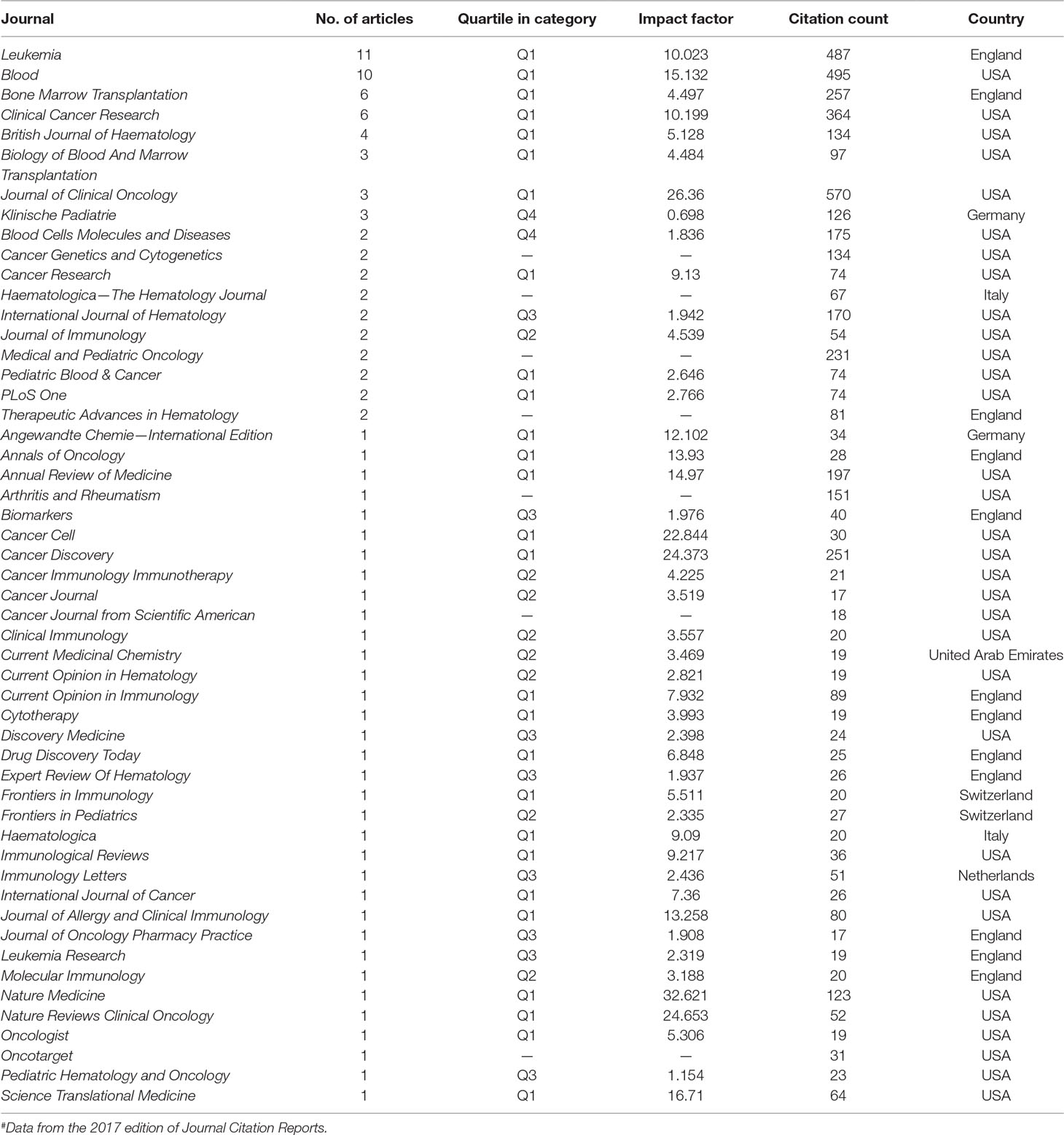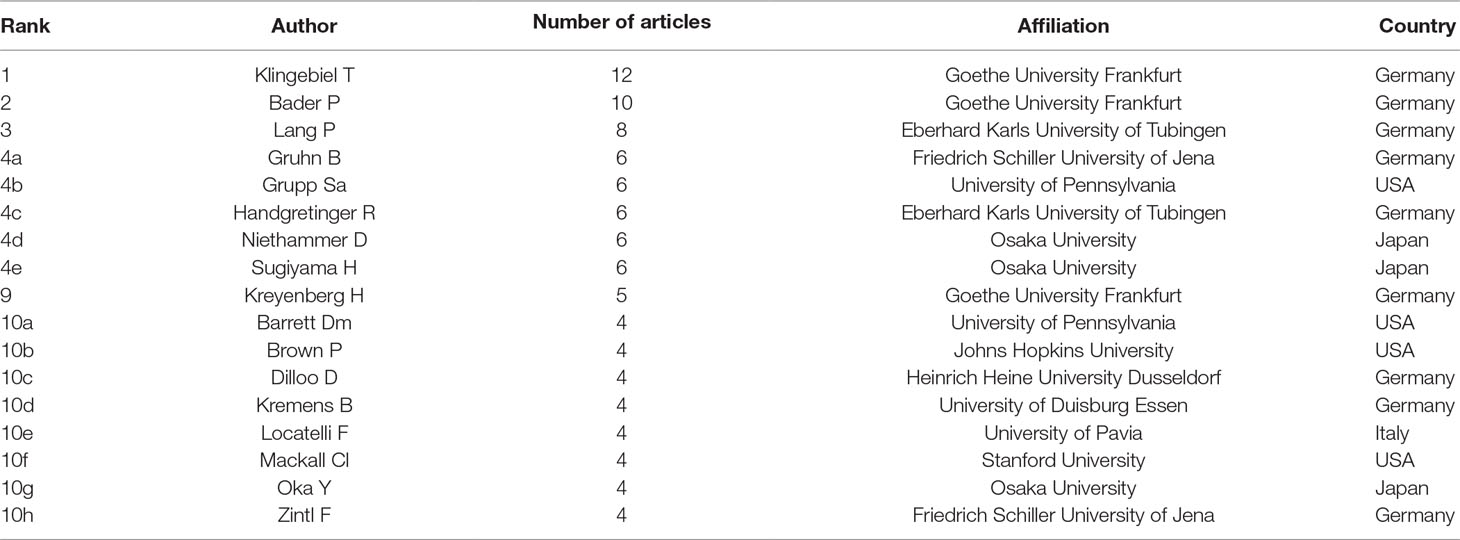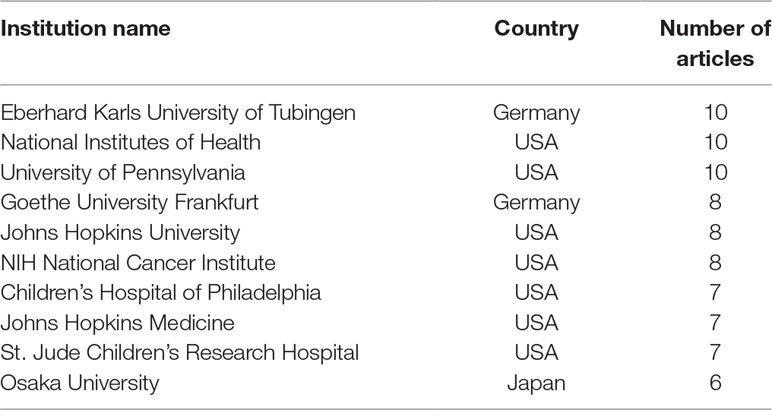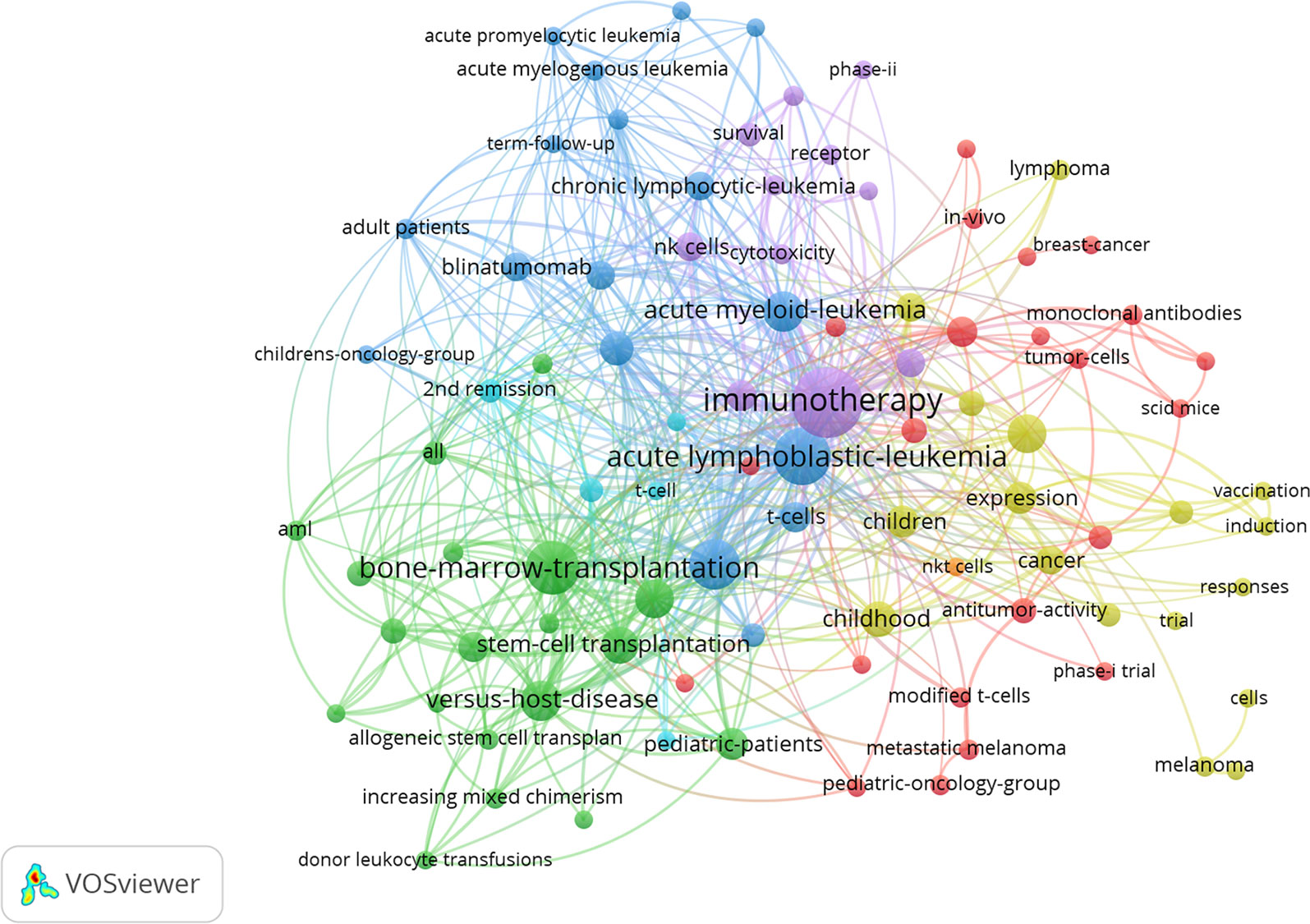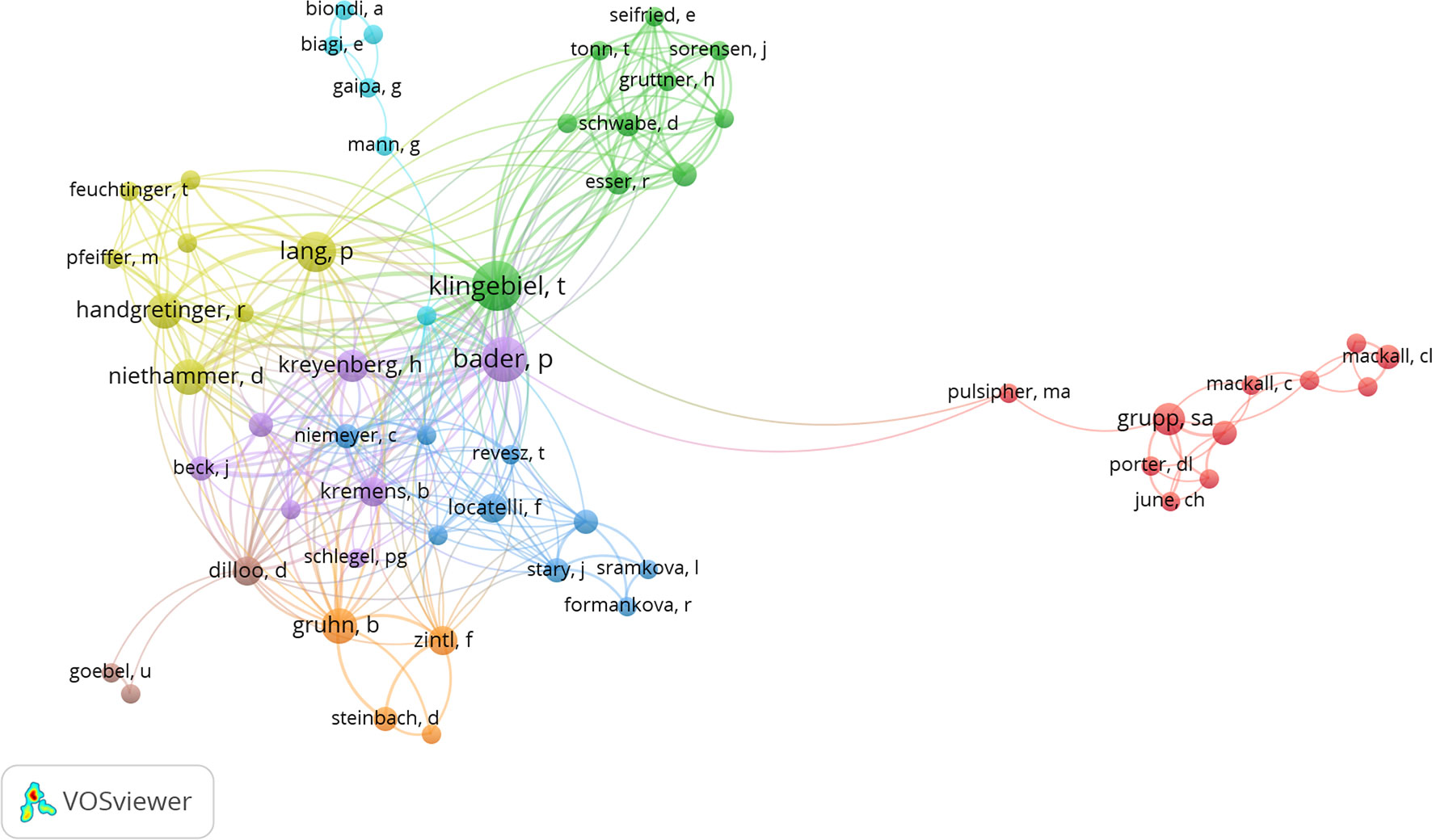- 1Department of Pediatrics, Guangzhou Hospital of Integrated Traditional and West Medicine, Guangzhou, China
- 2Center for Evidence-Based and Translational Medicine, Zhongnan Hospital of Wuhan University, Wuhan, China
- 3Center for Evidence-Based Medicine, Institute of Evidence-Based Medicine and Knowledge Translation, Henan University, Kaifeng, China
Background: Childhood leukemia is one of the most common cancers in children. As a potential treatment for leukemia, immunotherapy has become a new research hotspot. This research aimed at exploring the status and trends of current researches on immunotherapy for childhood leukemia through bibliometric analysis.
Methods: The Institute for Scientific Information Web of Science core collection database was searched for articles on immunotherapy and childhood leukemia using a computer. Time period for retrieval was from the beginning of the database to June 15, 2019. The top 100 highly cited articles were selected to extract their information on publication year, authors, title, publication journal, number of citations, author’s affiliations, country, and so on. These general information and bibliometric data were collected for analysis. VOSviewer software was used to generate a figure for keywords’ co-occurrence network and a figure for researcher’s coauthorship network that visualized reference and cooperation patterns for different terms in the 100 articles.
Results: The number of citations in the top 100 articles ranged from 17 to 471. These articles were published in 52 different publications. The top four journals in terms of the number of our selected articles were Leukemia (11 articles), Blood (10 articles), Bone Marrow Transplantation (6 articles), and Clinical Cancer Research. The most frequently nominated author was T. Klingebiel from Goethe University Frankfurt, and of the top 100 articles, 12 listed his name. These top 100 articles were published after the year 2000. Most of these articles were original (67%). The United States and Germany were the major countries researching immunotherapy for childhood leukemia and made significant contributions to the combat against the disease. Adoptive immunotherapy and stem cell transplantation appeared more frequently in keywords.
Conclusions: This study analyzed the top 100 highly cited articles on immunotherapy for childhood leukemia and provided insights into the features and research hotspots of the articles on this issue.
Introduction
Leukemia is a malignant clonal disease of hematopoietic stem cells (Greaves, 2016). It is estimated that this disease will see more than 0.4 million new cases and 0.3 million related deaths worldwide, according to the GLOBOCAN 2018 (Bray et al., 2018). And new leukemia cases account for 31% of new patients of childhood malignancies (Ward et al., 2014). Most children with leukemia show rapid onset (Miranda-Filho et al., 2018). Due to the complexity in leukemia typing and prognosis, there is no one-size-fits-all treatment for the disease (Pui et al., 2015; Lam et al., 2017). At present, main treatment methods for the disease contain the following types: chemotherapy (Saygin and Carraway, 2017), radiation therapy (Simone et al., 2012), targeted therapy (Mugoni et al., 2019), immunotherapy (Acheampong et al., 2018), stem cell transplantation (Cornelissen and Blaise, 2016), and the like. After reasonable and comprehensive treatment, the prognosis of leukemia has been greatly improved (Marcos-Gragera et al., 2017). A considerable number of patients can be cured or reach long-term stability (Pui et al., 2003; Lennmyr et al., 2019).
Immunotherapy, a new treatment for cancer, can help the immune system fight cancer (Majzner et al., 2017). Over the past few decades, immunotherapy has developed targeting cancer at a striking rate (Foster and Maude, 2018). There are many immunotherapies for leukemia, such as chimeric antigen receptor (CAR) T-cell therapy, bispecific T-cell engager (BiTE) therapy, and antibody-drug conjugates (ADCs) (Aldoss et al., 2017; June et al., 2018; Liu et al., 2019). Chimeric antigen receptor T-cell technology is the most influential immunotherapy for childhood leukemia in the last decade (Gardner et al., 2017). This measure uses autologous T cells to attack malignant cells (Wang et al., 2017). Studies have shown that CAR T cells are effective in inducing remission among leukemia patients and thus provide valuable opportunities for subsequent transplantation, finally achieving durable remission (Pan et al., 2019). Evidence also has shown that CAR–T-cell therapy can achieve fine effects among patients with recurrent B-cell malignancies or those facing relapse after cord blood transplant, with fewer complications (Fan et al., 2017). Bispecific T-cell engager therapy is also a new advance in immunotherapy for childhood leukemia. Preclinical studies have shown that BiTE can realize antileukemia function by targeting T cells and CD33+ monocyte myelogenous suppressor cells, recruiting and expanding autologous T cells and inducing acute myeloid leukemia -blasts lysis (Krupka et al., 2016; Jitschin et al., 2018). Antibody-drug conjugate therapy, another immunotherapy, has been widely concerned. In this approach, cytotoxic molecules could bind to antibodies, and then the antibodies specifically bind to specific tumor antigens, and the cytotoxic molecules would be endocytosed into cells, thereby killing tumor cell from inside (Foster and Maude, 2018). An in vitro experiment showed that ADCs could improve the antiproliferation and cytotoxicity of human acute lymphoblastic leukemia cell lines (Hicks et al., 2019). In the mouse model of leukemia, ADC treatment could significantly improve survival rate without overt toxicity or adverse effects (McGinn et al., 2017). As an effective antileukemia immunotherapy, ADC has been assessed for its safety and efficacy in leukemia patients (Li et al., 2018).
Immunotherapy is important in treating childhood leukemia, but there is no bibliometric analysis on researches in this field. The purpose of this study was to use bibliometric methods to analyze the top 100 highly cited articles on immunotherapy for childhood leukemia, hoping to have a better understanding of current situation and trend of those researches through analyzing their main characteristics.
Materials and Methods
Data Sources
Literature on immunotherapy for childhood leukemia was retrieved from Institute for Scientific Information (ISI) website of the Science Core Collection Database of Henan University from the beginning of the database to April 30, 2019 (updated to June 15, 2019). Childhood, pediatric, leukemia, and immunotherapy were used as search terms. Retrieved documents were arranged in descending order according to the number of citations, and the top 100 most cited articles were finally obtained.
Data Extraction
The top 100 most frequently cited articles were selected, and the following information was extracted from them: the number of citations, the names of the authors, authors’ affiliations, country, publication year, article title, article type, journal, Web of Science categories, quartile in category, and impact factor of the journal (2017 edition of Journal Citation Reports).
Two independent researchers evaluated each identified article to identify articles involving immunotherapy for childhood leukemia, regardless of article type. If there were different opinions, a third reviewer would be consulted, and consensus was thus achieved through discussion.
Statistical Analysis
Microsoft Excel 2013 software was used for descriptive statistical analyses, including those on publication year, author, author affiliation, country, journal, and citation number. VOSviewer 1.6.8 (van Eck and Waltman, 2010) was used to draw figures for keyword co-occurrence network and coauthored network, so as to implement network visualization analysis. In network visualization, each circle and label represented a keyword or researcher, and the size of circles represented the frequency of occurrence. The larger the circle was, more frequently the circle-represented body appeared. Circles adopting different colors in graph represented different clusters. Lines between two circles indicated that two keywords or researchers appeared together. The thicker the lines were, more frequently they appeared together. More relevant two keywords or researchers were, closer two circles located. The minimum number of co-occurrences was adjusted according to graphic results.
Results
Characteristics of Included Studies
A total of 360 articles were retrieved from the Web of Science Core Collection Database to introduce immunotherapy for childhood leukemia. Articles are listed in descending order according to the cited frequency; the top 100 articles with the highest cited frequency are selected. All of the top 100 highly cited articles were published between 2000 and 2018, about two to nine articles each year. Of the articles, 99 were published in journals and 1 in a book. These articles were in 19 categories, including hematology, oncology, and immunology. The 100 articles were published by researchers from 23 countries, most from the United States, Germany, Italy, and Japan (Figure 1). The 100 articles were published in 52 publications, 7 of which were not included in the 2017 edition of Journal Citation Reports. The quartile in category was distributed in Q1–Q4; impact factors of the journals ranged from 0.698 to 32.621, and basic information of the journals is shown in Table 1. The average and median number of citations, range of citation number, and interquartile range of the 100 articles were 53.2, 35.5, 17 to 471, and 35.25, respectively. The articles contained 67 original articles, 23 reviews, 6 conference abstracts, 2 letters, 1 editorial material, and 1 book chapter. The information of the top 100 highly cited articles is listed in Supplementary Table S1.
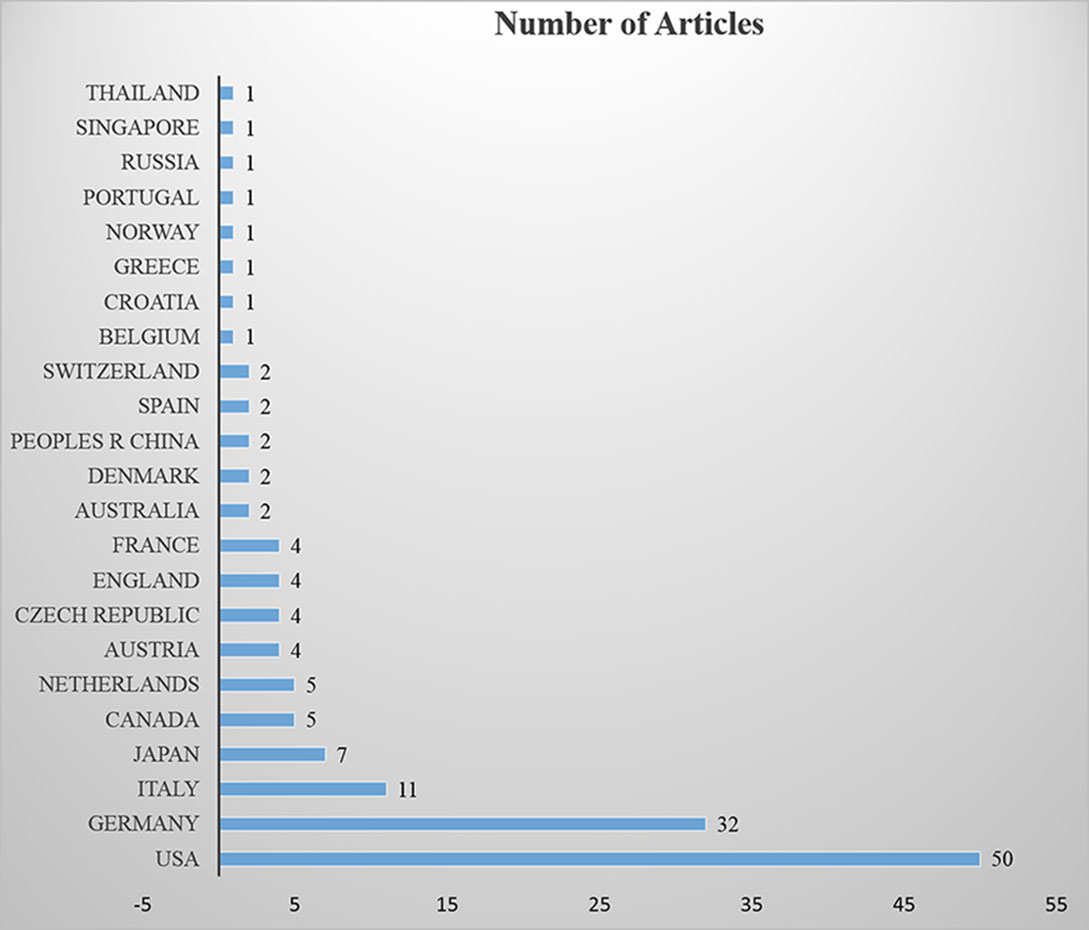
Figure 1 Countries from which the 100 most highly cited articles originated and the number of our collected articles from each of those countries.
The Top 10 Authors
Among the 100 articles, the researchers who published most articles were T. Klingebiel from Goethe University Frankfurt, Germany, reaching a total of 12 articles, while the second and third authors came from the same university. Of the top 10 authors, nine were from Germany, four from the United States, three from Japan, and one from Italy (Table 2).
The Top 10 Institutions
Like Eberhard Karls University of Tubingen and National Institutes of Health, the University of Pennsylvania, produced 10% of the top 100 articles, followed by the Goethe University Frankfurt (8%), Johns Hopkins University (8%), and National Cancer Institute (8%) (Table 3).
The Top 10 Articles
The top 10 highly cited articles contained four original articles, five reviews, and one book chapter (Table 4). They were from the United States, Italy, Germany, Japan, and Australia. Of the 10 articles, 6 were published in journals, which ranked Q1 in the 2017 edition of Journal Citation Reports, and 1 in that ranking Q3, while journals publishing the other 3 were not included in the 2017 edition of Journal Citation Reports. The categories of these journals involved blood, tumors, pediatrics, and the like. The top 10 articles covered the updating of treatments for childhood leukemia (Rodriguez-Galindo et al., 2003; Pui et al., 2011; Locatelli et al., 2012; Barrett et al., 2014), different mechanisms of immunotherapy (Sotillo et al., 2015; Fry et al., 2018), WT1 targeted therapy (Sugiyama, 2001; Rosenfeld et al., 2003), a case series report (Diak et al., 2010), and a clinical study (Dagher et al., 2002).
Keyword Co-Occurrence Network Visualization
VOSviewer software was used to draw a figure for keyword co-occurrence network, setting the minimum number of occurrences at 3. As shown in Figure 2, circles representing keywords such as acute lymphoblastic-leukemia, bone-marrow-transplantation, acute myeloid-leukemia, versus-host-disease, and stem cell transplantation are larger than others, indicating that these keywords appeared more frequently. Blinatumomab, a BiTE drug, has been extensively studied.
Researcher Coauthored Network Visualization
VOSviewer software was used to analyze coauthorship network of authors, with the minimum number of coauthors at 2, and figure for coauthorship network was drawn (Figure 3). Accordingly, circles representing T. Klingebiel, P. Bader, and P. Lang are larger than others, and connection lines between them were denser and thicker, indicating that they contributed to more collaborating articles and had closer relation.
Discussion
In this study, we identified and analyzed the top 100 highly cited articles in the field of immunotherapy for childhood leukemia. Through bibliometric analysis, the status and characteristics of publications in this field were explored, including publication journals, research institutions, authors, and other information. The trends of the most frequently cited articles in this field have been clarified, which provided ideas and directions for researchers.
According to publication years of the top 100 highly cited articles, every year could see two to nine articles highly cited, and only one-fourth of those articles were published in the past 5 years. Perhaps because immunotherapy is an emerging approach, a large amount of preclinical and clinical researches are still in progress. Among the top 100 articles, most were from European and American countries, few from Asia. Reason for such a phenomenon possibly is that leukemia has higher incidence in Europe and the United States. According to statistics, the risk of leukemia is 10 to 20 times higher in Europe and the United States than in Asia (Yang et al., 2015). Therefore, many research institutions in Europe and the United States have been exploring in this field. According to the number of citations, the most frequently cited articles in the top 100 ones were cited 471 times. Compared with other features (Liao et al., 2016; Wang et al., 2019), such figure was not large, probably because research in this field is still in the initial stage, and our research topic involved only the blood system and immunotherapy. However, considering physical, psychological, and financial burden from leukemia on the patients (Bosshard et al., 2018) and enormous potential of immunotherapy in treating this disease, researches in this area are important.
A total of 52 journals were involved in this study. The journals were arranged in descending order according to the number of the top 100 highly cited articles they published. The journals were divided into three groups, each with the same number of the articles, and then the number of journals in the three groups was 4, 14, and 34, respectively, approximate to 1:31:32. The distribution of these publications was consistent with Bradford’s Law (Bradford, 1985). Of the top 100 highly cited articles, 66% were published in Q1 (2017 edition of the journal citation report), 9% in Q2 and Q3, separately, and 5% in Q4. Most of them were published in journals possessing high impact factor, while these journals are often subscribed by more researchers, and high-quality research results face more opportunities to be cited (Callaham et al., 2002).
According to the results of keyword co-occurrence, the top 100 highly cited articles covered various aspects of immunotherapy for childhood leukemia, such as leukemia type, immunotherapy type, immunotherapy mechanism (Foster and Maude, 2018), immunotherapy experiments in vitro, animal experiments in vitro (McGinn et al., 2017; Hicks et al., 2019), preclinical studies, stem cell transplantation, changes in survival time after immunotherapy, and leukemia recurrence. According to the figure for keywords co-occurrence network, we can intuitively observe links between keywords and analyze hot topics of the researches. In recent years, a variety of immunotherapies have been approved for clinical leukemia treatment (Kantarjian et al., 2017; Kantarjian et al., 2018; Mueller et al., 2018; Jabbour et al., 2019). Growing preclinical studies have also been used to explore new immunotherapies for different types of leukemia.
From the figure for coauthorship network, coauthorship between authors and comparisons on the number of published articles can be visually observed. After multiple times of drawing network figure, the minimum times for author appearing was set at 2. Even so, most researchers were not presented in network diagram because they did not meet the conditions. Researchers in this field are scattered, and only few of them have published more articles. Researchers such as T. Klingebiel, P. Bader, P. Lang, and B. Gruhn from Germany were in close contact with other researchers in this field and have published more articles.
This study still had some limitations. On the one hand, some of the influential articles may be omitted. We only searched the ISI Web of Science core collection database, and articles in other sources such as PubMed and Scopus might be missed, so our final results may be affected by such operation (Riggs et al., 2017). On the other hand, the number of citations is only an index to evaluate academic influence of articles. Higher impact factors of journals, greater academic influence of authors in this field, Open Access publishing, higher visibility of institutions, and long publication time of literature may all have positive impact on the number of citations for articles (Calver and Bradley, 2010; Zhang and Poucke, 2017). Besides, the quality of the top 100 articles was not assessed, so the quality of the documents may be different. This may affect the interpretation of the results.
Conclusions
In this study, we analyzed the top 100 highly cited articles on immunotherapy for childhood leukemia via bibliometrics. Most of the articles were published after the year 2000 on top journals in the field of oncology and hematology. Adoptive immunotherapy and stem cell transplantation are the main topics in these articles, which contributed to the development and optimization of immunotherapy. The United States and European countries such as Germany and Italy were major original countries in this research field. Professor T. Klingebiel from Goethe University Frankfurt represented a leader in the field of immunotherapy for childhood leukemia. This report provided insights into the features and research hotspots of highly cited articles on immunotherapy for childhood leukemia.
Data Availability
All datasets generated for this study are included in the manuscript/Supplementary Files.
Author Contributions
Y-HJ designed this study. QZ and B-HL performed search and collected data. Q-QZ re-checked data. Z-MZ performed analysis, Z-HZ rechecked. QZ wrote the manuscript. Y-HJ reviewed the manuscript.
Conflict of Interest Statement
The authors declare that the research was conducted in the absence of any commercial or financial relationships that could be construed as a potential conflict of interest.
Supplementary Material
The Supplementary Material for this article can be found online at: https://www.frontiersin.org/articles/10.3389/fphar.2019.01100/full#supplementary-material
References
Acheampong, D. O., Adokoh, C. K., Asante, D. B., Asiamah, E. A., Barnie, P. A., Bonsu, D. O. M., et al. (2018). Immunotherapy for acute myeloid leukemia (AML): a potent alternative therapy. Biomed. Pharmacother. 97, 225–232. doi: 10.1016/j.biopha.2017.10.100
Aldoss, I., Bargou, R. C., Nagorsen, D., Friberg, G. R., Baeuerle, P. A., Forman, S. J. (2017). Redirecting T cells to eradicate B-cell acute lymphoblastic leukemia: bispecific T-cell engagers and chimeric antigen receptors. Leukemia 31 (4), 777–787. doi: 10.1038/leu.2016.391
Barrett, D.M., Singh, N., Porter, D.L., Grupp, S.A., June, C.H. (2014). Chimeric antigen receptor therapy for cancer. Annu. Rev. Med. 65, 333–347. doi: 10.1146/annurev-med-060512-150254
Bosshard, R., O’Reilly, K., Ralston, S., Chadda, S., Cork, D. (2018). Systematic reviews of economic burden and health-related quality of life in patients with acute myeloid leukemia. Cancer Treat. Rev. 69, 224–232. doi: 10.1016/j.ctrv.2018.07.005
Bray, F., Ferlay, J., Soerjomataram, I., Siegel, R. L., Torre, L. A., Jemal, A. (2018). Global cancer statistics 2018: GLOBOCAN estimates of incidence and mortality worldwide for 36 cancers in 185 countries. CA Cancer J. Clin. 68 (6), 394–424. doi: 10.3322/caac.21492
Callaham, M., Wears, R. L., Weber, E. (2002). Journal prestige, publication bias, and other characteristics associated with citation of published studies in peer-reviewed journals. JAMA 287 (21), 2847–2850. doi: 10.1001/jama.287.21.2847
Calver, M. C., Bradley, J. S. (2010). Patterns of citations of open access and non-open access conservation biology journal papers and book chapters. Conserv. Biol. 24 (3), 872–880. doi: 10.1111/j.1523-1739.2010.01509.x
Cornelissen, J. J., Blaise, D. (2016). Hematopoietic stem cell transplantation for patients with AML in first complete remission. Blood 127 (1), 62–70. doi: 10.1182/blood-2015-07-604546
Dagher, R., Long, L. M., Read, E. J., Leitman, S. F., Carter, C. S., Tsokos, M., et al. (2002). Pilot trial of tumor-specific peptide vaccination and continuous infusion interleukin-2 in patients with recurrent Ewing sarcoma and alveolar rhabdomyosarcoma: an inter-institute NIH study. Med. Pediatr. Oncol. 38 (3), 158–164. doi: 10.1002/mpo.1303
Diak, P., Siegel, J., La Grenade, L., Choi, L., Lemery, S., McMahon, A. (2010). Tumor necrosis factor alpha blockers and malignancy in children forty-eight cases reported to the Food and Drug Administration. Arthritis and Rheum. 62 (8), 2517–2524. doi: 10.1002/art.27511
Fan, M., Li, M., Gao, L., Geng, S., Wang, J., Wang, Y., et al. (2017). Chimeric antigen receptors for adoptive T cell therapy in acute myeloid leukemia. J. Hematol. Oncol. 10 (1), 151. doi: 10.1186/s13045-017-0519-7
Foster, J. B., Maude, S. L. (2018). New developments in immunotherapy for pediatric leukemia. Curr. Opin. Pediatr. 30 (1), 25–29. doi: 10.1097/MOP.0000000000000572
Fry, T. J., Shah, N. N., Orentas, R. J., Stetler-Stevenson, M., Yuan, C. M., Ramakrishna, S., et al. (2018). CD22-targeted CAR T cells induce remission in B-ALL that is naive or resistant to CD19-targeted CAR immunotherapy. Nat. Med. 24 (1), 20–2+. doi: 10.1038/nm.4441
Gardner, R. A., Finney, O., Annesley, C., Brakke, H., Summers, C., Leger, K., et al. (2017). Intent-to-treat leukemia remission by CD19 CAR T cells of defined formulation and dose in children and young adults. Blood 129 (25), 3322–3331. doi: 10.1182/blood-2017-02-769208
Greaves, M. (2016). Leukaemia ‘firsts’ in cancer research and treatment. Nat. Rev. Cancer 16 (3), 163–172. doi: 10.1038/nrc.2016.3
Hicks, S.W., Tarantelli, C., Wilhem, A., Gaudio, E., Li, M., Arribas, A.J., et al. (2019). The novel CD19-targeting antibody-drug conjugate huB4-DGN462 shows improved anti-tumor activity compared to SAR3419 in CD19-positive lymphoma and leukemia models. Haematologica 104 (8), 1633–1639. doi: 10.3324/haematol.2018.211011
Jabbour, E.J., Sasaki, K., Ravandi, F., Short, N.J., Garcia-Manero, G., Daver, N., et al. (2019). Inotuzumab ozogamicin in combination with low-intensity chemotherapy (mini-HCVD) with or without blinatumomab versus standard intensive chemotherapy (HCVAD) as frontline therapy for older patients with Philadelphia chromosome-negative acute lymphoblastic leukemia: A propensity score analysis. Cancer 125 (15), 2579–2586. doi: 10.1002/cncr.32139
Jitschin, R., Saul, D., Braun, M., Tohumeken, S., Völkl, S., Kischel, R., et al. (2018). CD33/CD3-bispecific T-cell engaging (BiTE®) antibody construct targets monocytic AML myeloid-derived suppressor cells. J. Immunother. Cancer 6 (1), 116. doi: 10.1186/s40425-018-0432-9
June, C. H., O’Connor, R. S., Kawalekar, O. U., Ghassemi, S., Milone, M. C. (2018). CAR T cell immunotherapy for human cancer. Science 359 (6382), 1361–1365. doi: 10.1126/science.aar6711
Kantarjian, H., Stein, A., Gokbuget, N., Fielding, A. K., Schuh, A. C., Ribera, J. M., et al. (2017). Blinatumomab versus chemotherapy for advanced acute lymphoblastic leukemia. N. Engl. J. Med. 376 (9), 836–847. doi: 10.1056/NEJMoa1609783
Kantarjian, H. M., Su, Y., Jabbour, E. J., Bhattacharyya, H., Yan, E., Cappelleri, J. C., et al. (2018). Patient-reported outcomes from a phase 3 randomized controlled trial of inotuzumab ozogamicin versus standard therapy for relapsed/refractory acute lymphoblastic leukemia. Cancer 124 (10), 2151–2160. doi: 10.1002/cncr.31317
Krupka, C., Kufer, P., Kischel, R., Zugmaier, G., Lichtenegger, F. S., Kohnke, T., et al. (2016). Blockade of the PD-1/PD-L1 axis augments lysis of AML cells by the CD33/CD3 BiTE antibody construct AMG 330: reversing a T-cell–induced immune escape mechanism. Leukemia 30 (2), 484–491. doi: 10.1038/leu.2015.214
Lam, S. S., He, A. B., Leung, A. Y. (2017). Treatment of acute myeloid leukemia in the next decade - Towards real-time functional testing and personalized medicine. Blood Rev. 31 (6), 418–425. doi: 10.1016/j.blre.2017.08.001
Lennmyr, E., Karlsson, K., Ahlberg, L., Garelius, H., Hulegardh, E., Izarra, A.S., et al. (2019). Survival in adult acute lymphoblastic leukaemia (ALL): A report from the Swedish ALL Registry. Eur. J. Haematol. 103 (2), 88–98. doi: 10.1111/ejh.13247
Li, F., Sutherland, M. K., Yu, C., Walter, R. B., Westendorf, L., Valliere-Douglass, J., et al. (2018). Characterization of SGN-CD123A, a potent CD123-directed antibody-drug conjugate for acute myeloid leukemia. Mol. Cancer Ther. 17 (2), 554–564. doi: 10.1158/1535-7163.MCT-17-0742
Liao, J., Wang, J., Liu, Y., Li, J., He, Q., Jiang, W., et al. (2016). The most cited articles in coronary heart disease: a bibliometric analysis between 1970 and 2015. Int. J. Cardiol. 222, 1049–1052. doi: 10.1016/j.ijcard.2016.08.002
Liu, D., Zhao, J., Song, Y., Luo, X., Yang, T. (2019). Clinical trial update on bispecific antibodies, antibody-drug conjugates, and antibody-containing regimens for acute lymphoblastic leukemia. J. Hematol. Oncol. 12 (1), 15. doi: 10.1186/s13045-019-0703-z
Locatelli, F., Schrappe, M., Bernardo, M. E., Rutella, S. (2012). How I treat relapsed childhood acute lymphoblastic leukemia. Blood 120 (14), 2807–2816. doi: 10.1182/blood-2012-02-265884
Majzner, R. G., Heitzeneder, S., Mackall, C. L. (2017). Harnessing the immunotherapy revolution for the treatment of childhood cancers. Cancer Cell 31 (4), 476–485. doi: 10.1016/j.ccell.2017.03.002
Marcos-Gragera, R., Galceran, J., Martos, C., de Munain, A. L., Vicente-Raneda, M., Navarro, C., et al. (2017). Incidence and survival time trends for Spanish children and adolescents with leukaemia from 1983 to 2007. Clin. Transl. Oncol. 19 (3), 301–316. doi: 10.1007/s12094-016-1531-z
McGinn, O. J., Krishnan, S., Bourquin, J. P., Sapra, P., Dempsey, C., Saha, V., et al. (2017). Targeting the 5T4 oncofetal glycoprotein with an antibody drug conjugate (A1mcMMAF) improves survival in patient-derived xenograft models of acute lymphoblastic leukemia. Haematologica 102 (6), 1075–1084. doi: 10.3324/haematol.2016.158485
Miranda-Filho, A., Pineros, M., Ferlay, J., Soerjomataram, I., Monnereau, A., Bray, F. (2018). Epidemiological patterns of leukaemia in 184 countries: a population-based study. Lancet Haematol. 5 (1), e14–e24. doi: 10.1016/S2352-3026(17)30232-6
Mueller, K. T., Waldron, E., Grupp, S. A., Levine, J. E., Laetsch, T. W., Pulsipher, M. A., et al. (2018). Clinical pharmacology of tisagenlecleucel in B-cell acute lymphoblastic leukemia. Clin. Cancer Res. 24 (24), 6175–6184. doi: 10.1158/1078-0432.CCR-18-0758
Mugoni, V., Panella, R., Cheloni, G., Chen, M., Pozdnyakova, O., Stroopinsky, D., et al. (2019). Vulnerabilities in mIDH2 AML confer sensitivity to APL-like targeted combination therapy. Cell Res. 29 (6), 446–459. doi: 10.1038/s41422-019-0162-7
Pan, J., Niu, Q., Deng, B., Liu, S., Wu, T., Gao, Z., et al. (2019). CD22 CAR T-cell therapy in refractory or relapsed B acute lymphoblastic leukemia. Leukemia [Epub ahead of print]. doi: 10.1038/s41375-019-0488-7
Pui, C. H., Carroll, W. L., Meshinchi, S., Arceci, R. J. (2011). Biology, risk stratification, and therapy of pediatric acute leukemias: an update. J. Clin. Oncol. 29 (5), 551–565. doi: 10.1200/JCO.2010.30.7405
Pui, C. H., Cheng, C., Leung, W., Rai, S. N., Rivera, G. K., Sandlund, J. T., et al. (2003). Extended follow-up of long-term survivors of childhood acute lymphoblastic leukemia. N. Engl. J. Med. 349 (7), 640–649. doi: 10.1056/NEJMoa035091
Pui, C. H., Yang, J. J., Hunger, S. P., Pieters, R., Schrappe, M., Biondi, A., et al. (2015). Childhood acute lymphoblastic leukemia: progress through collaboration. J. Clin. Oncol. 33 (27), 2938–2948. doi: 10.1200/JCO.2014.59.1636
Riggs, C. A., Cornes, K., Godwin, H. J., Liversedge, S. P., Guest, R., Donnelly, N. (2017). The importance of search strategy for finding targets in open terrain. Cogn. Res. Princ. Implic. 2 (1), 14. doi: 10.1186/s41235-017-0049-4
Rodriguez-Galindo, C., Spunt, S. L., Pappo, A. S. (2003). Treatment of Ewing sarcoma family of tumors: current status and outlook for the future. Med. Pediatr. Oncol. 40 (5), 276–287. doi: 10.1002/mpo.10240
Rosenfeld, C., Cheever, M. A., Gaiger, A. (2003). WT1 in acute leukemia, chronic myelogenous leukemia and myelodysplastic syndrome: therapeutic potential of WT1 targeted therapies. Leukemia 17 (7), 1301–1312. doi: 10.1038/sj.leu.2402988
Saygin, C., Carraway, H. E. (2017). Emerging therapies for acute myeloid leukemia. J. Hematol. Oncol. 10 (1), 93. doi: 10.1186/s13045-017-0463-6
Simone, C. B., Morris, J. C., Stewart, D. M., Urquhart, N. E., Janik, J. E., Kreitman, R. J., et al. (2012). Radiation therapy for the management of patients with HTLV-1–associated adult T-cell leukemia/lymphoma. Blood 120 (9), 1816–1819. doi: 10.1182/blood-2012-01-401349
Sotillo, E., Barrett, D. M., Black, K. L., Bagashev, A., Oldridge, D., Wu, G., et al. (2015). Convergence of acquired mutations and alternative splicing oF CD19 enables resistance to CART-19 immunotherapy. Cancer Discov. 5 (12), 1282–1295. doi: 10.1158/2159-8290.CD-15-1020
Sugiyama, H. (2001). Wilms’ tumor gene WT1: its oncogenic function and clinical application. Int. J. Hematol. 73 (2), 177–187. doi: 10.1007/BF02981935
van Eck, N. J., Waltman, L. (2010). Software survey: VOSviewer, a computer program for bibliometric mapping. Scientometrics 84 (2), 523–538. doi: 10.1007/s11192-009-0146-3
Wang, C. Y., Li, B. H., Ma, L. L., Zhao, M. J., Deng, T., Jin, Y. H., et al. (2019). The top-100 highly cited original articles on drug therapy for ventilator-associated pneumonia. Front. Pharmacol. 10, 108. doi: 10.3389/fphar.2019.00108
Wang, Z., Wu, Z., Liu, Y., Han, W. (2017). New development in CAR–T cell therapy. J. Hematol. Oncol. 10 (1), 53. doi: 10.1186/s13045-017-0423-1
Ward, E., DeSantis, C., Robbins, A., Kohler, B., Jemal, A. (2014). Childhood and adolescent cancer statistics, 2014. CA Cancer J. Clin. 64 (2), 83–103. doi: 10.3322/caac.21219
Yang, S. M., Li, J. Y., Gale, R. P., Huang, X. J. (2015). The mystery of chronic lymphocytic leukemia (CLL): why is it absent in Asians and what does this tell us about etiology, pathogenesis and biology? Blood Rev. 29 (3), 205–213. doi: 10.1016/j.blre.2014.12.001
Keywords: childhood leukemia, immunotherapy, bibliometrics, Web of Science, VOSviewer
Citation: Zhong Q, Li B-H, Zhu Q-Q, Zhang Z-M, Zou Z-H and Jin Y-H (2019) The Top 100 Highly Cited Original Articles on Immunotherapy for Childhood Leukemia. Front. Pharmacol. 10:1100. doi: 10.3389/fphar.2019.01100
Received: 22 June 2019; Accepted: 26 August 2019;
Published: 24 September 2019.
Edited by:
Yonggang Zhang, Sichuan University, ChinaReviewed by:
Adina Turcu-Stiolica, University of Medicine and Pharmacy of Craiova, RomaniaYaser Mohammed Al-Worafi, Ajman University of Science and Technology, United Arab Emirates
Copyright © 2019 Zhong, Li, Zhu, Zhang, Zou and Jin. This is an open-access article distributed under the terms of the Creative Commons Attribution License (CC BY). The use, distribution or reproduction in other forums is permitted, provided the original author(s) and the copyright owner(s) are credited and that the original publication in this journal is cited, in accordance with accepted academic practice. No use, distribution or reproduction is permitted which does not comply with these terms.
*Correspondence: Ying-Hui Jin, jinyinghuiebm@163.com
 Qing Zhong1
Qing Zhong1 Bing-Hui Li
Bing-Hui Li Ying-Hui Jin
Ying-Hui Jin